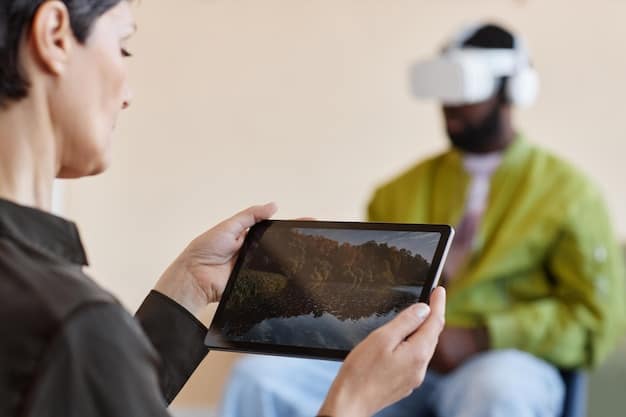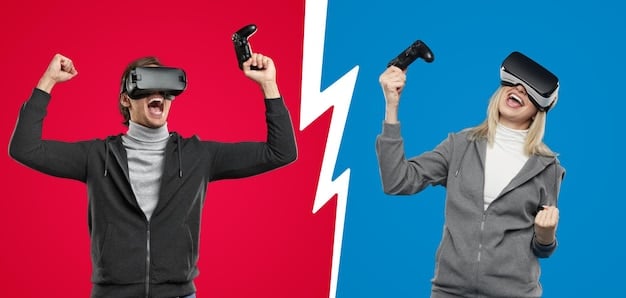Virtual Reality for PTSD Treatment: Helping US Veterans Heal

Virtual reality (VR) is increasingly used to treat post-traumatic stress disorder (PTSD) in US veterans by creating controlled, immersive environments that allow them to safely process traumatic memories, reducing anxiety and improving mental health outcomes.
For US veterans grappling with post-traumatic stress disorder (PTSD), the road to recovery can be arduous. But what if technology could offer a new path to healing? How is Virtual Reality Being Used to Treat PTSD in US Veterans? This innovative approach is transforming mental healthcare.
Virtual reality: a new frontier in PTSD treatment
Virtual reality (VR) is emerging as a promising tool in the treatment of various mental health conditions, including PTSD. Its immersive and interactive nature provides a unique platform for recreating traumatic experiences in a controlled and safe environment. Let’s explore how VR is making a difference in the lives of veterans.
What is virtual reality exposure therapy (VRET)?
Virtual reality exposure therapy (VRET) is a form of exposure therapy that uses VR technology to simulate real-life situations or environments that trigger PTSD symptoms. This allows veterans to confront their traumatic memories in a controlled and therapeutic setting.
How does VRET work?
During VRET sessions, veterans wear a VR headset and are immersed in a virtual environment that gradually exposes them to trauma-related stimuli. With the guidance of a therapist, they can process their emotions and develop coping mechanisms.

The use of VR in PTSD treatment offers several advantages:
- Safety: VR provides a safe space for veterans to confront traumatic memories without the risk of re-traumatization.
- Control: Therapists can carefully control the intensity and duration of exposure, tailoring the experience to each veteran’s specific needs.
- Accessibility: VR technology can potentially increase access to mental healthcare for veterans in remote areas or those with mobility issues.
In summary, VR exposure therapy offers a safe, controlled, and accessible way for veterans to confront and process traumatic memories, ultimately promoting healing and recovery.
The science behind VR and PTSD treatment
The effectiveness of VR in treating PTSD can be attributed to its ability to engage the brain’s natural fear extinction processes. By repeatedly exposing veterans to trauma-related stimuli in a safe context, VR helps to reduce the emotional impact of traumatic memories.
Fear extinction and VR
Fear extinction is a learning process in which the brain learns to associate a previously feared stimulus with safety. VR environments provide the ideal setting for this process to occur, as they allow veterans to confront their fears without real-world consequences.
Neuroplasticity and VR
Neuroplasticity, the brain’s ability to reorganize itself by forming new neural connections, also plays a key role in the effectiveness of VR for PTSD. By engaging with virtual environments, veterans can strengthen new neural pathways that promote resilience and emotional regulation.
Furthermore, studies have shown that VR therapy leads to significant improvements in PTSD symptoms, including:
- Reduced anxiety and avoidance behaviors
- Decreased nightmares and intrusive thoughts
- Improved emotional regulation and coping skills
In short, VR therapy leverages the brain’s natural processes of fear extinction and neuroplasticity to help veterans overcome PTSD symptoms and regain control of their lives.
The virtual environments used in PTSD treatment
One of the key aspects of VR therapy for PTSD is the creation of realistic and tailored virtual environments. These environments are designed to recreate the specific situations or contexts that trigger a veteran’s PTSD symptoms.
Customizing VR environments
VR environments can be customized to match the unique experiences of each veteran. This may involve recreating specific locations, sounds, and visual details related to their traumatic experiences.
Examples of VR environments
Some common examples of VR environments used in PTSD treatment include:
- Virtual war zones that simulate combat situations
- Virtual city streets that recreate the sights and sounds of urban environments
- Virtual social situations that address social anxiety and avoidance behaviors

The goal of these VR environments is to provide veterans with a sense of presence and immersion, allowing them to fully engage with the therapeutic process. By confronting their traumatic memories in a realistic and controlled setting, veterans can begin to process their emotions and develop coping strategies.
In essence, the ability to customize VR environments to match individual experiences is a crucial element in the effectiveness of VR therapy for PTSD, enabling veterans to confront their specific triggers in a safe and tailored manner.
Challenges and limitations of VR therapy for PTSD
While VR therapy holds great promise for treating PTSD in veterans, it is important to acknowledge the challenges and limitations associated with this approach.
Cost and accessibility
The cost of VR equipment and software can be a barrier to access for some veterans and mental healthcare providers. Additionally, the availability of trained therapists who can administer VR therapy may be limited in certain areas.
Potential for adverse reactions
Some veterans may experience adverse reactions to VR therapy, such as motion sickness, anxiety, or flashbacks. It is important for therapists to carefully monitor veterans during VR sessions and to provide appropriate support and guidance.
Furthermore, there are questions about:
- The long-term effectiveness of VR therapy
- The generalizability of findings from clinical trials to real-world settings
- The ethical considerations surrounding the use of VR in mental healthcare
Despite these challenges, ongoing research and development efforts are focused on addressing these limitations and improving the accessibility and effectiveness of VR therapy for PTSD.
The role of the therapist in VR therapy
The therapist plays a crucial role in the success of VR therapy for PTSD. They provide guidance, support, and encouragement to veterans throughout the therapeutic process.
Assessment and treatment planning
Before beginning VR therapy, the therapist will conduct a thorough assessment of the veteran’s PTSD symptoms and traumatic experiences. This information is used to develop a personalized treatment plan that addresses the veteran’s specific needs.
Facilitating exposure and processing
During VR sessions, the therapist helps the veteran navigate the virtual environment, confront their traumatic memories, and process their emotions. They also provide coping strategies and relaxation techniques to manage anxiety and distress.
The therapist’s role extends beyond the VR session to include:
- Providing education about PTSD and VR therapy
- Monitoring the veteran’s progress and adjusting the treatment plan as needed
- Addressing any concerns or questions the veteran may have
In conclusion, the therapist’s expertise and support are essential for ensuring that VR therapy is a safe, effective, and positive experience for veterans with PTSD.
Future directions and innovations in VR therapy
The field of VR therapy is constantly evolving, with ongoing research and development efforts focused on improving its effectiveness, accessibility, and ease of use.
Integration of biofeedback
Integrating biofeedback technology into VR therapy may allow therapists to monitor veterans’ physiological responses during VR sessions and to tailor the experience to their individual needs. This could lead to more personalized and effective treatment.
Development of new VR environments
Researchers are also working on developing new VR environments that address a wider range of traumatic experiences and PTSD symptoms. This could include virtual environments that simulate natural disasters, accidents, or other types of trauma.
Other potential innovations include:
- The use of artificial intelligence to personalize VR therapy
- The development of mobile VR platforms that can be used at home
- The integration of VR therapy with other forms of mental healthcare
In the future, VR therapy is likely to become an increasingly important tool in the treatment of PTSD and other mental health conditions, offering new hope and healing for veterans and others who have experienced trauma.
| Key Point | Brief Description |
|---|---|
| 🧠 VR Exposure Therapy | Uses virtual scenarios to safely confront traumatic memories. |
| 🛡️ Controlled Environment | Offers a secure setting to process emotions without real-world risks. |
| 📈 Improved Outcomes | Leads to reduced anxiety, better emotional regulation, and enhanced coping skills. |
| 💡 Future Innovations | Includes biofeedback integration and personalized AI therapy. |
Frequently Asked Questions
▼
Virtual reality exposure therapy (VRET) uses VR to simulate real-life situations, helping veterans safely confront and process traumatic memories, ultimately reducing PTSD symptoms.
▼
VR creates a controlled environment for veterans to confront triggers, facilitating fear extinction and neuroplasticity, which helps them regain emotional regulation and cope effectively.
▼
Yes, VR therapy provides a safe space for veterans. Therapists carefully manage the exposure intensity, minimizing the risk of re-traumatization while maximizing therapeutic benefits.
▼
Limitations include the cost of equipment, limited access to trained therapists, and potential adverse reactions like motion sickness. Ongoing research is addressing these challenges.
▼
The therapist assesses the veteran, develops a personalized treatment plan, guides them through VR sessions, and provides continuous support, ensuring a safe and effective therapeutic experience.
Conclusion
As technology continues to advance, virtual reality offers a groundbreaking approach to treating PTSD in US veterans. By providing safe, controlled, and customizable environments, VR therapy allows veterans to confront their traumatic memories, develop coping strategies, and ultimately heal from the invisible wounds of war. With ongoing research and innovation, VR is poised to revolutionize mental healthcare for those who have served our country.





